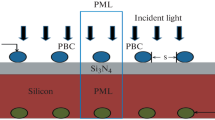Abstract
Introducing periodic Ag gratings in the rear side of thin-film silicon excites localized surface plasmon (LSP) and Fabry-Perot (FP) effect. These two effects as well as an intrinsic one pass through absorption overlay together and all contribute to the light absorption in silicon. On the basis of electromagnetic field’s linear superposition, the absorptivity caused by LSP effect is separated from the overall absorptivity of a 500-nm-thick silicon and quantized by short current density. Finite difference time domain (FDTD) calculations were performed to obtain the absorptivity of silicon with different Ag grating parameters. The contribution of LSP effect to the light absorption is evaluated by photocurrent ratio and investigated under different Ag grating parameters. It is found that, as LSP effect is excited most intensively, the light absorption of silicon will also be enhanced extremely. By careful design, the overall short current density of silicon is optimized up to 25.4 mA/cm2, where the contribution of LSP effect accounts for 38.6 %. Comparing to 14.5 mA/cm2 for a reference silicon stack, it increases up to almost 75 %. These results may give design suggestions in implementation of plasmonic solar cell as high efficiency devices.






Similar content being viewed by others
References
Technology roadmap: solar photovoltaic energy-2014 edition. International Energy Agency. 2014, http://www.iea.org/publications/freepublications/publication/
Panasonic HIT® solar cell achieves world’s highest energy conversion efficiency of 25.6% at research level. Panasonic press release, 2014. http://panasonic.co.jp/corp/news/official.data/data.dir/2014/04/en1404104/en140410-4.html
Spinelli P, Polman A (2014) Light trapping in thin crystalline Si solar cells using surface mie scatterers. IEEE J Photovoltaics 4:554–559
Nam WJ, Fischer D, Gray Z, Nguyen N, Ji L, Neidich D, Fonash SJ (2015) 30% increase in available photons per cell area using nanoelement array light trapping in 700-nm-Thick nc-Si solar cells. IEEE J Photovoltaics 5:28–32
Sun C, Wang XQ (2015) Efficient light trapping structures of thin film silicon solar cells based on silver nanoparticle arrays. Plasmonics 10:1307–1314
Atwater HA, Polman A (2010) Plasmonics for improved photovoltaic devices. Nat Mater 9:205–213
Deceglie MG, Ferry VE, Alivisatos AP, Atwater HA (2012) Design of nanostructured solar cells using coupled optical and electrical modeling. Nano Lett 12:2894–2900
Kosten ED, Newman BK, Lloyd JV, Polman A, Atwater HA (2015) Limiting light escape angle in silicon photovoltaics: ideal and realistic cells. IEEE J Photovoltaics 5:61–69
Pala RA, White J, Barnard E, Liu J, Brongersma ML (2009) Design of plasmonic thin-film solar cells with broadband absorption enhancements. Adv Mater 21:3504–3509
Wen L, Sun FH, Chen Q (2014) Cascading metallic gratings for broadband absorption enhancement in ultrathin plasmonic solar cells. Appl Phys Lett 104:151106
Meng XQ, Drouard E, Gomard G, Peretti R, Fave A, Seassal C (2012) Combined front and back diffraction gratings for broad band light trapping in thin film solar cell. Opt Express 20:A560–A571
Xing K, Wang Z, Yu ZF, Liu V, Cui Y, Fan SH (2012) Absorption enhancement in ultrathin crystalline silicon solar cells with antireflection and light-trapping nanocone gratings. Nano Lett 12:1616–1619
Bermel P, Luo CY, Zeng LR, Kimerling LC, Joannopoulos JD (2007) Improving thin-film crystalline silicon solar cell efficiencies with photonic crystals. Opt Express 15:16986–17000
Oskooi AF, Roundy D, Ibanescu M, Bermel P, Joannopoulos JD, Johnson SG (2010) MEEP: a flexible freesoftware package for electromagnetic simulations by the FDTD method. Comput Phys Commun 181:687–702
Palik ED, Ghosh G (1985) Handbook of optical constants of solids. Academic, New York
Spinelli P, Ferry VE, Groep J, Lare M, Verschuuren MA, Schropp REI, Atwater HA, Polman A (2012) Plasmonic light trapping in thin-film Si solar cells. J Opt 14:024002
Dragoman M, Dragoman D (2008) Plasmonics: applications to nanoscale terahertz and optical devices. Prog Quantum Electron 32:1–41
Joannopoulos JD, Johnson SG, Winn JN, Meade RD (2008) Photonic crystals: molding the flow of light, 2nd edn. Princeton University Press, New Jersey
Kong A (1986) Electromagnetic wave theory. Wiley, New Jersey
ASTMG173-03, Standard Tables for Reference Solar Spectral Irradiances: Direct Normal and Hemispherical on 37 degree Tilted Surface .ASTM International:West Conshohocken, Pennsylvania, 2005
Theuring M, Wang PH, Vehse M, Steenhoff V, Maydell K, Agert C, Brolo AG (2014) Comparison of Ag and SiO2 nanoparticles for light trapping applications in silicon thin film solar cells. J Phys Chem Lett 5:3302–3306
Acknowledgments
This work is supported by the research and innovation project of Shanghai Municipal Education Commission (No.14YZ162) and Shanghai university young teachers training project (No.14AZ20). The authors would like to thank Dr. Ardavan Oskooi from MIT for his help of suggestions on program debugging.
Author information
Authors and Affiliations
Corresponding author
Rights and permissions
About this article
Cite this article
Rao, L., Ji, CL. & Li, M. Contribution of LSP Effect to Light Absorption in Thin-Film Crystalline Silicon Solar Cells. Plasmonics 12, 229–235 (2017). https://doi.org/10.1007/s11468-016-0254-x
Received:
Accepted:
Published:
Issue Date:
DOI: https://doi.org/10.1007/s11468-016-0254-x




